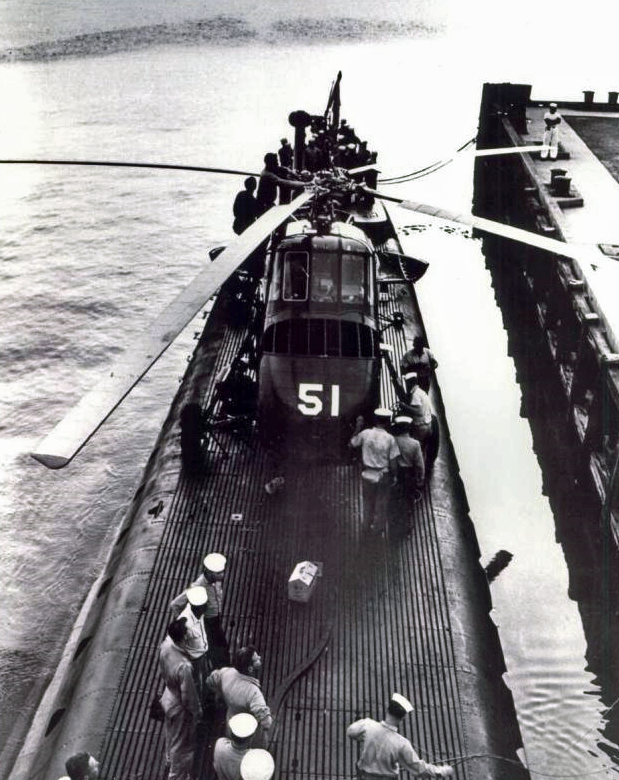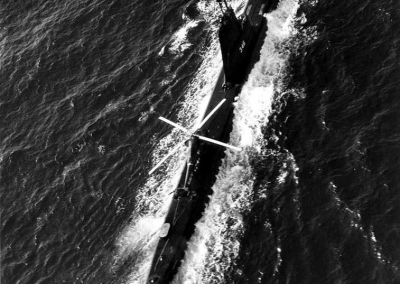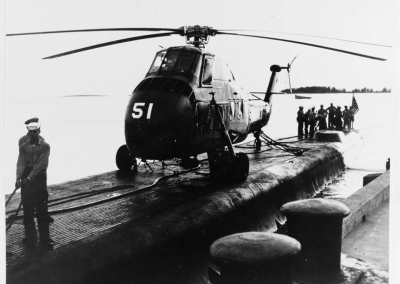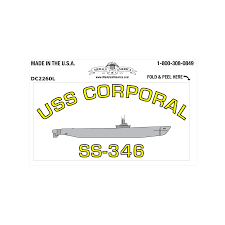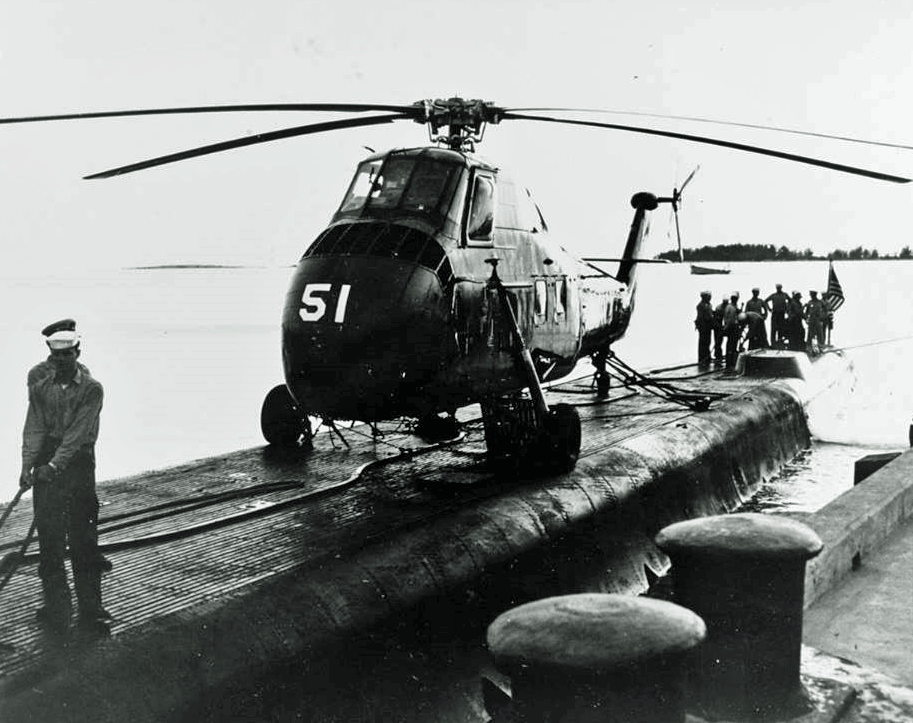

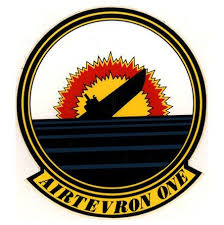
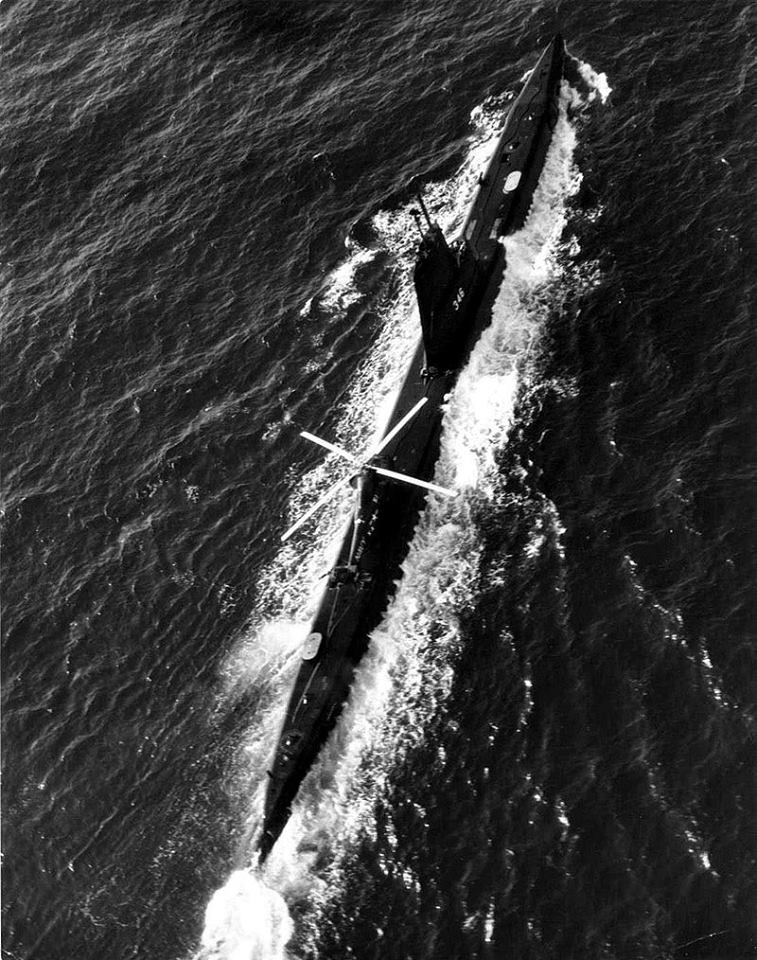
USS Corporal (SS-346): First Submarine To Reel in a Helicopter!
By Charles G. Hood, MD
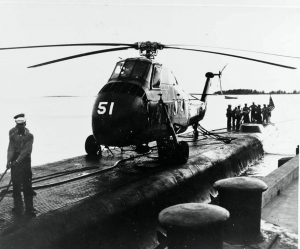 On Thursday, 26 April 1956, off the southern coast of Florida about 20 miles from Key West, Cmdr. William F. Culley of Augusta, Georgia noticed a problem mid-flight. Culley, the pilot of Navy helicopter #51 on an antisubmarine warfare (ASW) training run as part of Squadron VX-1, realized that he was losing oil quickly from the main rotor assembly. He was too far from the coast to return for an emergency landing. Culley’s mind raced as he considered his options. Bailing was certainly possible, giving Culley and his three fellow crewmembers the best opportunity to survive the incident, although at the cost of a very expensive Navy helicopter—the Sikorsky HSS-1, known as the Seabat because of its ASW package. Finding a small cay in the vicinity to land on would be ideal, but a sweep of the ocean landscape failed to show any small land masses that might have provided such an opportunity. Crashing into the ocean was not a desirable option. Culley, his co-pilot Lt. J. K. Johnson, and two other crewmembers, G.A. DeChamp (SO3) and M.R. Dronz (AT2), realized that they had precious minutes to make a decision before mechanical failure required a costly abandonment. A “May-Day” call was sent from the helicopter in hopes that another Navy or even merchant vessel could lend a hand.
On Thursday, 26 April 1956, off the southern coast of Florida about 20 miles from Key West, Cmdr. William F. Culley of Augusta, Georgia noticed a problem mid-flight. Culley, the pilot of Navy helicopter #51 on an antisubmarine warfare (ASW) training run as part of Squadron VX-1, realized that he was losing oil quickly from the main rotor assembly. He was too far from the coast to return for an emergency landing. Culley’s mind raced as he considered his options. Bailing was certainly possible, giving Culley and his three fellow crewmembers the best opportunity to survive the incident, although at the cost of a very expensive Navy helicopter—the Sikorsky HSS-1, known as the Seabat because of its ASW package. Finding a small cay in the vicinity to land on would be ideal, but a sweep of the ocean landscape failed to show any small land masses that might have provided such an opportunity. Crashing into the ocean was not a desirable option. Culley, his co-pilot Lt. J. K. Johnson, and two other crewmembers, G.A. DeChamp (SO3) and M.R. Dronz (AT2), realized that they had precious minutes to make a decision before mechanical failure required a costly abandonment. A “May-Day” call was sent from the helicopter in hopes that another Navy or even merchant vessel could lend a hand.
 Meanwhile, not far from the distressed chopper, the USS Corporal (SS-346), assigned to the submarine base at Key West, was submerged, also participating in the ASW exercises as a designated opposing boat. The Corporal was a Balao-class submarine. She was built at the Electric Boat shipyard in Groton, Connecticut and commissioned shortly after the conclusion of World War II in November 1945. She carried a complement of 10 officers and about 70 enlisted men. The Corporal was 312 feet in length with a beam of 27 feet, 3 inches. As it turned out, she would need every inch of that beam for her next unscheduled assignment.
Meanwhile, not far from the distressed chopper, the USS Corporal (SS-346), assigned to the submarine base at Key West, was submerged, also participating in the ASW exercises as a designated opposing boat. The Corporal was a Balao-class submarine. She was built at the Electric Boat shipyard in Groton, Connecticut and commissioned shortly after the conclusion of World War II in November 1945. She carried a complement of 10 officers and about 70 enlisted men. The Corporal was 312 feet in length with a beam of 27 feet, 3 inches. As it turned out, she would need every inch of that beam for her next unscheduled assignment.
The radio shack of the Corporal intercepted the May-Day call from the disabled helicopter. This news was communicated immediately to the sub’s skipper, Lt. Cmdr. Erman O. Proctor in the Conn. He wasted little time. “Emergency surface. Blow all main ballast.” The words reverberated over the sub’s 1-MC as the Corporal executed an emergency blow and came to the surface with a gargantuan splash. In contact with the helicopter, Proctor ascertained that the chopper could remain airborne for only a short time longer. Culley requested the Corporal to make heavy knots in his direction to pick up survivors should the need to ditch the helicopter arise.
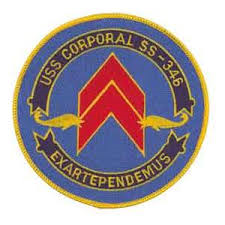 The Corporal radioed that they were on their way to the scene directly and then proceeded at flank speed to the provided coordinates of the helicopter. In just a few minutes, the Corporal made it first visual contact of the stationary helicopter suspended only a short distance above the ocean surface. Moving in to the helicopter’s immediate vicinity, Proctor had an idea that he shared with Culley. “How about attempting an on-deck landing?” The reply from the helicopter was emphatic: “Hell yes, let’s give it a go.” Absolutely no one wanted to see a valuable asset plunge needlessly to the ocean depths; the replacement price for the Sikorsky helicopter was about $250,000.
The Corporal radioed that they were on their way to the scene directly and then proceeded at flank speed to the provided coordinates of the helicopter. In just a few minutes, the Corporal made it first visual contact of the stationary helicopter suspended only a short distance above the ocean surface. Moving in to the helicopter’s immediate vicinity, Proctor had an idea that he shared with Culley. “How about attempting an on-deck landing?” The reply from the helicopter was emphatic: “Hell yes, let’s give it a go.” Absolutely no one wanted to see a valuable asset plunge needlessly to the ocean depths; the replacement price for the Sikorsky helicopter was about $250,000.
The Corporal carefully positioned itself directly under the still-hovering helicopter. Communications between helicopter and submarine continued at a fast and furious pace. The mechanical issue with the helicopter prevented it from turning in any direction; hovering was still functional, but no adjustment in heading could be made from the cockpit. Once the Corporal understood this problem, the submarine maneuvered herself in the open seas such that her after deck was lined up with the landing wheels of the helicopter.
There were two critical issues to ponder. First, was the beam of the submarine wide enough to accommodate the landing wheels of the helicopter? The answer to that question wasn’t immediately clear to those crewmembers of the Corporal who had gone topside to inspect the underside of the hovering helicopter. (The “recovery party” in this case consisted of volunteers headed up by the COB.) Second, assuming that there was enough room from side to side, could the pilot of the helicopter bring her down in the very tight window from fore to aft on the submarine deck without striking the sail with its main rotor or the fantail with its rear rotor? Since no one had ever seriously contemplated the answers to these questions, all the men could do was to look closely and guess. To all who were there, it seemed like a very tight proposition, but there seemed to be just enough room from fore to aft and from port to starboard along the after deck to give it a shot. Still, given the vagaries of the sea and wind conditions that could shift the relative positions of the submarine and helicopter, the whole idea was incredibly risky. However, short of dumping the chopper there seemed to be no other viable alternatives, so the submarine crew prepared for the surprise drop-in.
The COB and his topside men had no protocol manual to draw from. They simply relied on their instincts to mitigate the risks of the impending landing—such as taking down the long wire antenna to avoid an inadvertent snag. The men then grabbed mooring lines in preparation for the next step. The helicopter began its final descent as pilot Culley attempted to keep his bird directly over the centerline of the submarine hull. Except for one intrepid sailor, the members of the recovery party stayed crouched at a safe distance just forward of the sail during this time. The person who volunteered to remain in harm’s way was engineering officer LTJG George Ellis, who braced himself along the after edge of the sail and provided hand signals for the pilot to fine-tune his landing. Ellis’ role was critical as the margin for error was razor-thin. He risked serious injury or even death from any errant move during his makeshift role as a signal officer, as the main rotor blades of the descending helicopter spun very close to his head.
The radio shack of the sub sent the message, “Do you think you will make it?” Any response from the helicopter was delayed, since the message was received just as the three wheels of the helicopter (2 front, 1 rear) made contact with the weather deck. The landing had to be absolutely perfect, and fortunately the seas had become mercifully calm during the attempt. With the precise teamwork between the hand signals of LTJG Ellis and the considerable skill of the helicopter pilot, the bird miraculously touched down. Incredibly, a small part of each front wheel ended up overhanging the deck edge on each side, but there was just enough room for most of the rubber for the helicopter to remain stable topside. The men on board estimated that an inch or two wider span on the landing gear would have made the attempt a no-go.
“We’re on your deck and damn happy to be here!”, came the relieved reply from the helicopter. The pilot had stuck the landing on the very first try. The recovery party rushed over with their mooring lines to tie up the helicopter to the submarine. It was the first time that a submarine had ever rescued a helicopter, and it was entirely coincidental (and fortuitous) that the width of the submarine deck was just wide enough to accommodate the helicopter’s landing gear.
Once the blades of the helicopter had spun to a complete stop and the assembly was properly secured, the crew emerged onto the deck, where they were met by LCDR Proctor. “Welcome aboard!”, offered the skipper, in perhaps one of the most unusual unplanned visits in submarine history. The guests were escorted down the hatch and offered food and drink, while the Corporal steamed back to the Naval Annex at Key West, arriving just before sunset around 1830 hours local time. Word had spread about the plight of the helicopter and the unconventional heroism aboard the Corporal that had saved her; as a result, a large crowd had gathered spontaneously at the pier to greet both submarine and helicopter. It must have been quite a curious sight to witness the sleek submarine heading into her berth with the most unlikely bounty lashed to her dorsal hull.
Navy mechanics made the necessary repairs to the helicopter rotor casing after a large crane lifted the bird from its precipitous perch on the Corporal. The broken oil casing was replaced, and the chopper again was ready for flight. Subsequently, the four-man crew climbed back into the cabin to depart, after grateful handshakes had been exchanged all around. Giving the thumbs up, CDR Culley started the main engine, and those assembled at the pier to see the chopper off held onto their hats as the big bird took to the sky. In minutes, the helicopter was out of sight, and the men of the Corporal had themselves the yarn of a lifetime—about the big one that didn’t get away.
About the Author
Dr. Charles G. Hood, a physician in hospital practice as a diagnostic radiologist in South Carolina, lives and works in South Carolina. Dr. Hood enjoys writing and genealogy. He has no previous military experience, but his brother Frank served as a nukes junior officer on the USS Seahorse between 1969 and 1972. Dr. Hood and his brother Frank cowrote the book, entitled, “POOPIE SUITS AND COWBOY BOOTS” , by Charles G. Hood and Frank Hood.
If you would like a copy of this book, click on the link above. The book is only $15, and $10 of this goes directly to the USSVI Submarine Scholarship Fund. The book is nearly 500 pages, with 100 historical photos and 19 original stories playing a detailed exclamation of the history and day-to-day activities aboard a Cold War attack submarine.
Dr. Hood wrote the featured story, “USS Corporal (SS-346): First Submarine To Reel in a Helicopter!,” earlier this year, 2019. He posted it to the submarine history page on Facebook, entitled “Poopie Suits and Cowboy Boots” in April, 2019, where the story has gone somewhat viral, with more than 130,000 hits in two weeks.
NHA and NHAHS would like to thank Dr. Charles G. Hood for giving us permission to publish this story on the NHAHS website for all our members and readers to enjoy.
